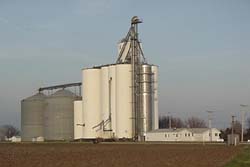|
According
to the 1997 Census of Agriculture (agriculture gets its own census
every five years similar to the 10-year general census most folks
are now filling out) Logan County farms sold an average of
$180,310 worth of agricultural products per farm. The total 1997
Logan County ag products sales figure was $133,249,000. Crop sales
accounted for about 84 percent of this total with livestock sales
taking the remaining 16 percent.
Farm
acres in 1997 were 380,921 in Logan County. Do the math with 640
acres in a square mile, and that should be about 595 square miles
of land used to produce food. The average farm was 515 acres in
1997, and would certainly be larger today. Full time farm numbers
fell to 511 in 1997, down from 612 five years earlier. This is
because of a trend toward both ends of the spectrum. On one hand,
commercial farms are rapidly growing in size. This means existing
farmers are taking up ground made available by those getting out
of the business. The other extreme is the "farmette" or
hobby farm that might be 20 acres or less, but is still classified
as a farm. Even though farm numbers may be holding close to
steady, the number of farmers doing most of the producing has
dropped off drastically.

Crop
farmers in Logan County traditionally have good yields. According
to the Illinois Crop Reporting Service, our producers averaged 158
bushels of corn per acre and 50 bushels of soybeans per acre in
1999. This translates to over 27 million bushels of corn from
Logan County worth over $55,000,000 at just $2.00 per bushel.
Soybeans would be almost equally valuable with almost 8,500,000
bushels worth over $40,000,000 at $4.80 per bushel value. While
corn and soybeans are the main crops grown in the county, there
are other crops such as wheat, hay, herbs, ornamentals and other
specialty crops.
|
Livestock
is also big business in stature with 1997 market values of over
$121,000,000 produced on our county farms. Beef cattle were on 166
farms with over 6700 head, hogs on 72 farms and almost 90,000 in
number, and sheep on 29 farms with almost 600 head. There are
still a couple of dairy farms and a few smaller egg producers, but
not like we used to have. The numbers of producers and head of
livestock in these operations is not even reported in Logan County
anymore because of the very low numbers.
According
to the 1999 Summary of Illinois Farm Business Records, the actual
average costs to produce commodities looks like this: a bushel of
corn, $2.93; a bushel of soybeans, $7.45; a pound of pork, 41
cents; a pound of beef, 58 cents; and to produce a gallon of milk,
$1.14. Keep in mind that the livestock production costs are for
live weight basis. When animals are processed for consumption, we
generally get about 65 percent of live weight back from hogs and
cattle.
Agriculture
week is a great time to bring "this business of farming"
into the spotlight for a short time. In Logan County, agriculture
and the people involved in the food chain do an outstanding job of
producing safe, abundant and relatively low-cost products for
consumers to enjoy.
[John
Fulton, unit leader,
Logan
County Extension Unit]
|

